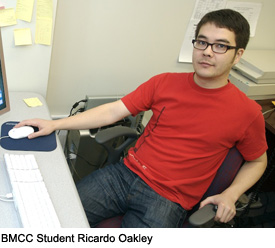
For years, BMCC’s Writing Across the Curriculum (W.A.C.) program has tried to show students that writing is not something to be scared of, but something to embrace. It’s never been an easy sell.
However, starting this semester, all entering BMCC students are required to take at least one Writing Intensive (WI) course in order to graduate. That left the W.A.C. program pondering how to best convey to BMCCers that the required classes shouldn’t be feared. The solution: put it to students themselves to design a branding logo.
Students eventually created one the W.A.C. program loved, and now, all the information the program has can be found on the W.A.C. program’s new Web site. But before getting to work on designing the branding, students needed to learn exactly what Writing Intensive courses were all about.
What Is WI? What Can It Do for Me?
Contrary to some beliefs, WI classes do not differ in content from other courses students take. The difference is this: WI classes are usually smaller, meaning more time for discussion and individual instruction, and add emphasis on writing to help students process the material.
The idea of the classes, according to W.A.C. coordinator Gay Brookes, “is to use both formal and informal writing as a way to foster critical thinking and communication skills and to construct knowledge.”
The program first trains faculty in the planning and implementation of writing-intensive courses. Professors then use writing to help students understand course concepts and applications, to analyze and connect ideas, and to remember what they’ve learned. Assignments range from journals and freewriting to longer papers, where the emphasis is on revision.
Students who have taken WI courses say it has challenged and expanded their cognitive and critical abilities, and helped them get far more out of their coursework than they thought possible.
“I found I had an much easier time grasping concepts, and learning became much more than a matter of memorizing dates and facts,” says Anibal Sanchez-Reyes, who was introduced to the WI model in a sociology course taught by Professor Rifat Salam. “I’m now able to read material without having to give myself a headache trying to figure out what the author is talking about. It’s something I know I can apply to other courses.”
Plus, the WI credits may prove useful when you transfer, especially to a college that has a Writing Intensive course requirement.
Student Design Contest
Wanting to get all of that across to students at BMCC, the W.A.C. program went to a few classes, including Professor Cynthia Karasek and her Multimedia Project Lab class.
“The program had been looking for an opportunity to work with students,” she said. “I knew right away it was something the class could bite into.”
Karasek turned the idea into the final assignment for her class, which usually includes a project based on the end result being used in a real world setting.
“I think the students reacted well, but it wasn’t as easy as they thought it would initially be,” she said. “The hard part was not only coming up with characters but to get the students to refine the characters, and the storylines, over and over again until they really had the message. I had to help them put into words and pictures these subtle changes to get exactly what we wanted.”
The winners: Ricardo Oakley and Ray Calderon, who designed a pencil-wielding red-dressed superhero with a “WI” on his chest.
“The last project in the class is always competitive,” Karasek said. “Knowing it was going to be used at BMCC added a bit of incentive. In the end, they enjoyed it. They look back on it as a challenge.”

